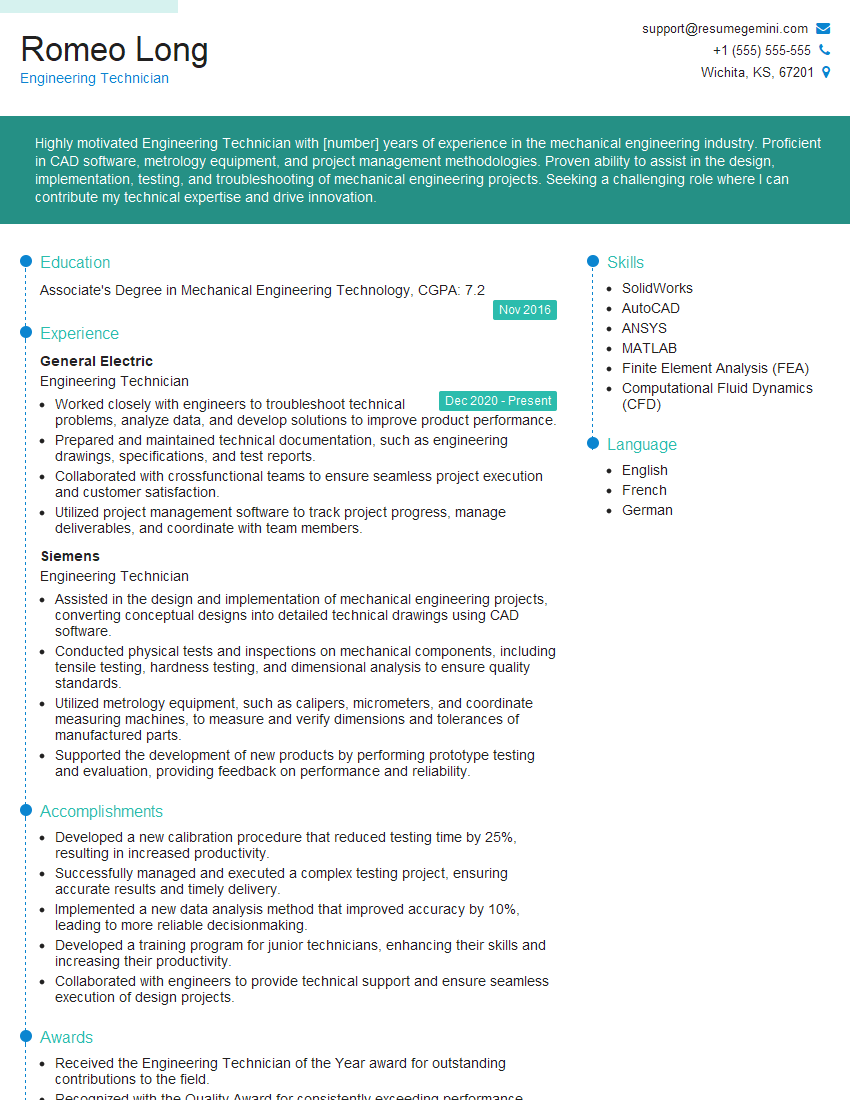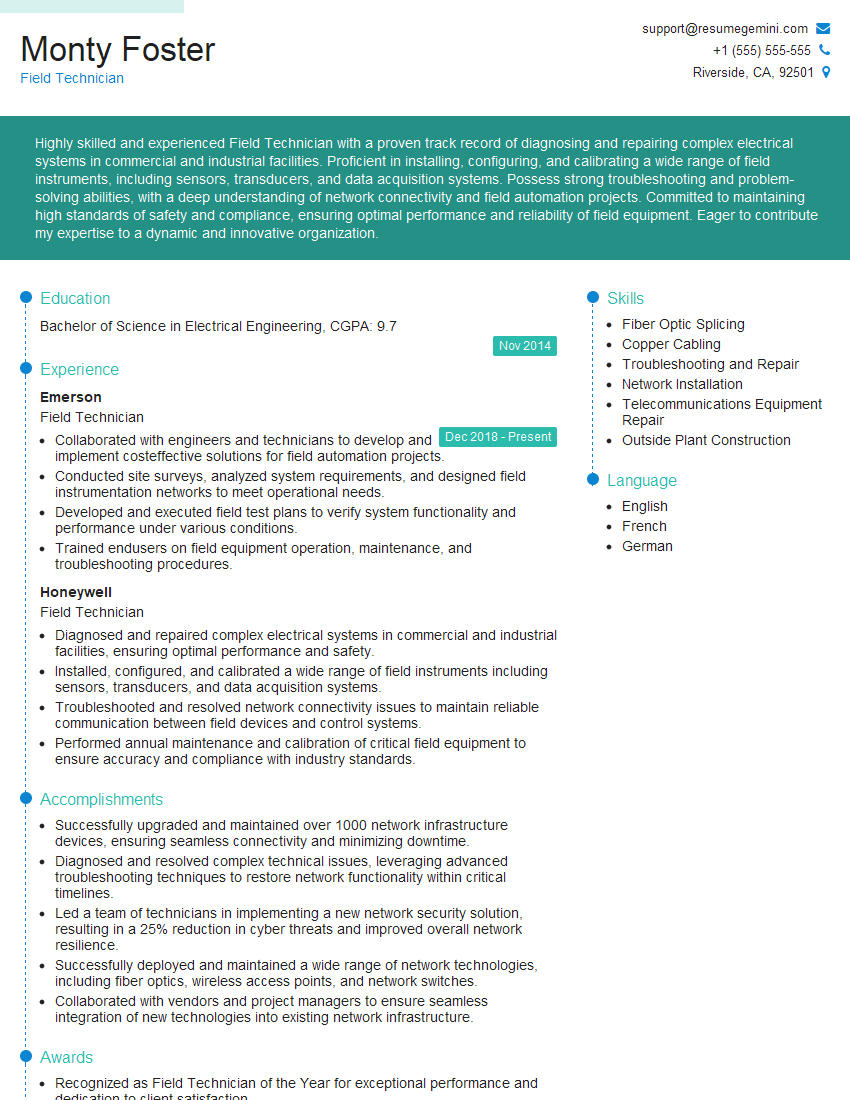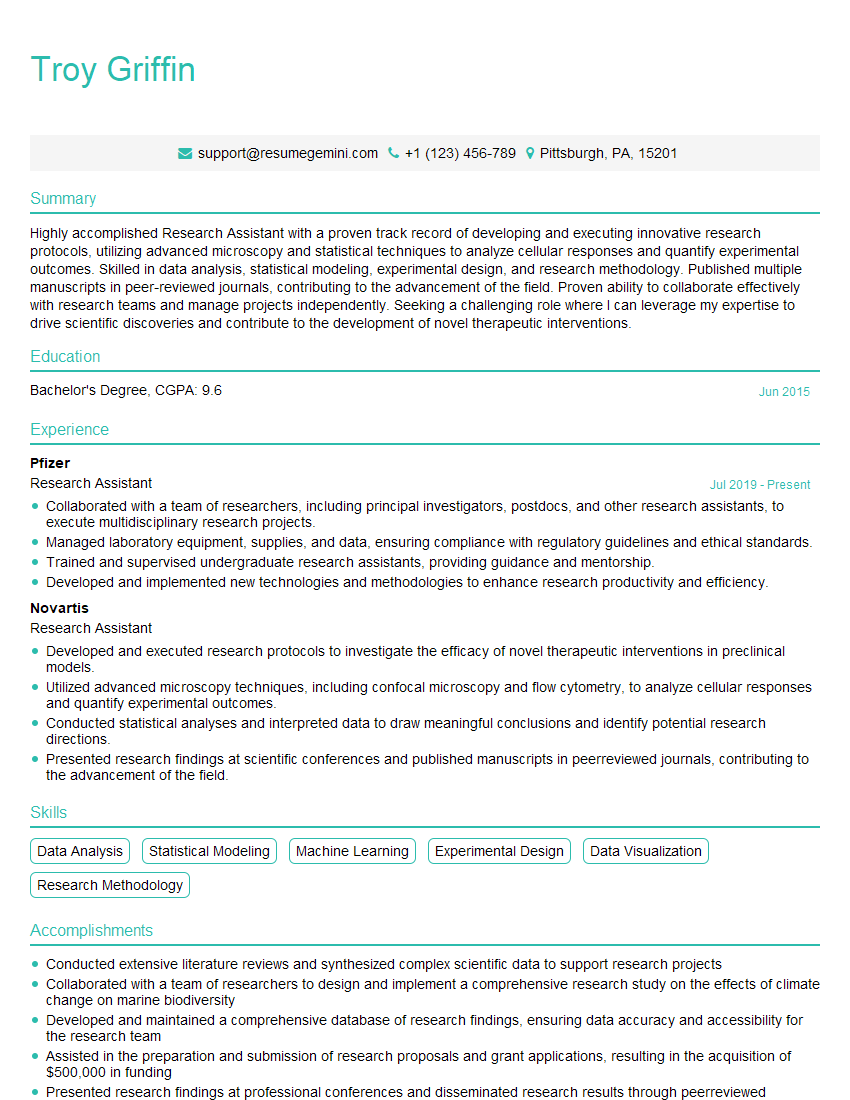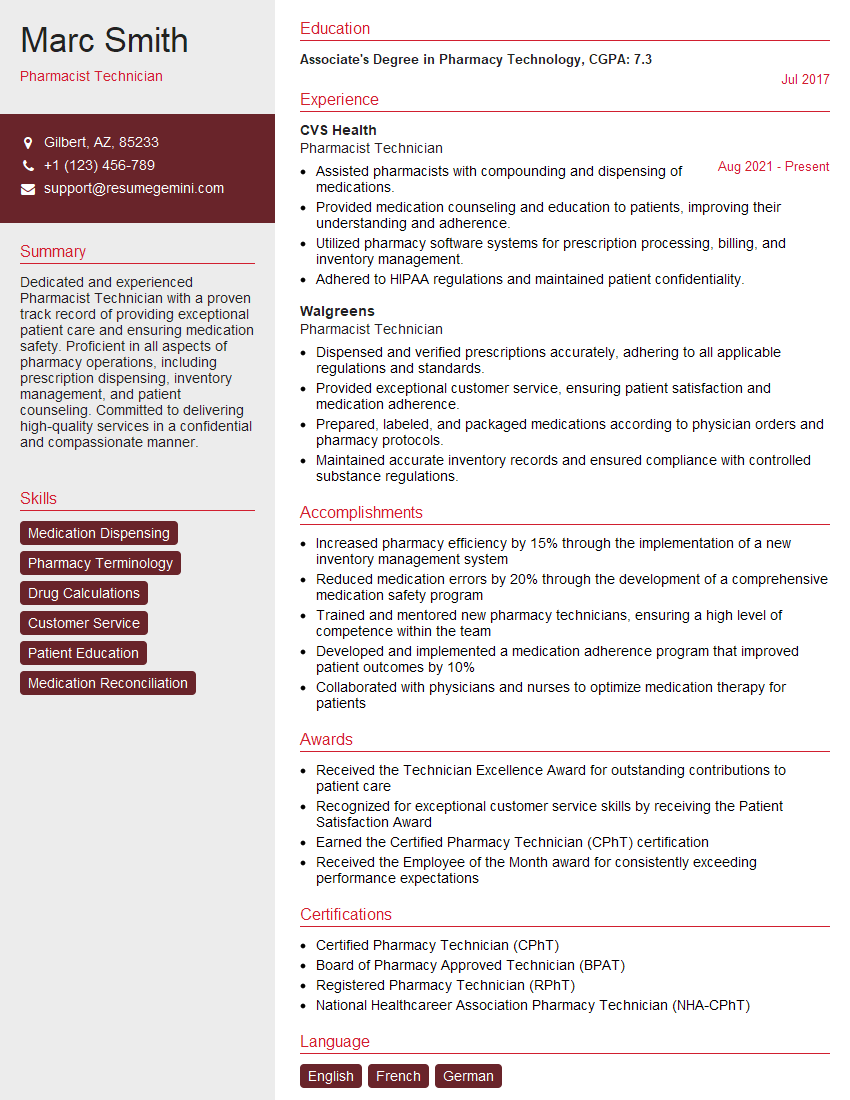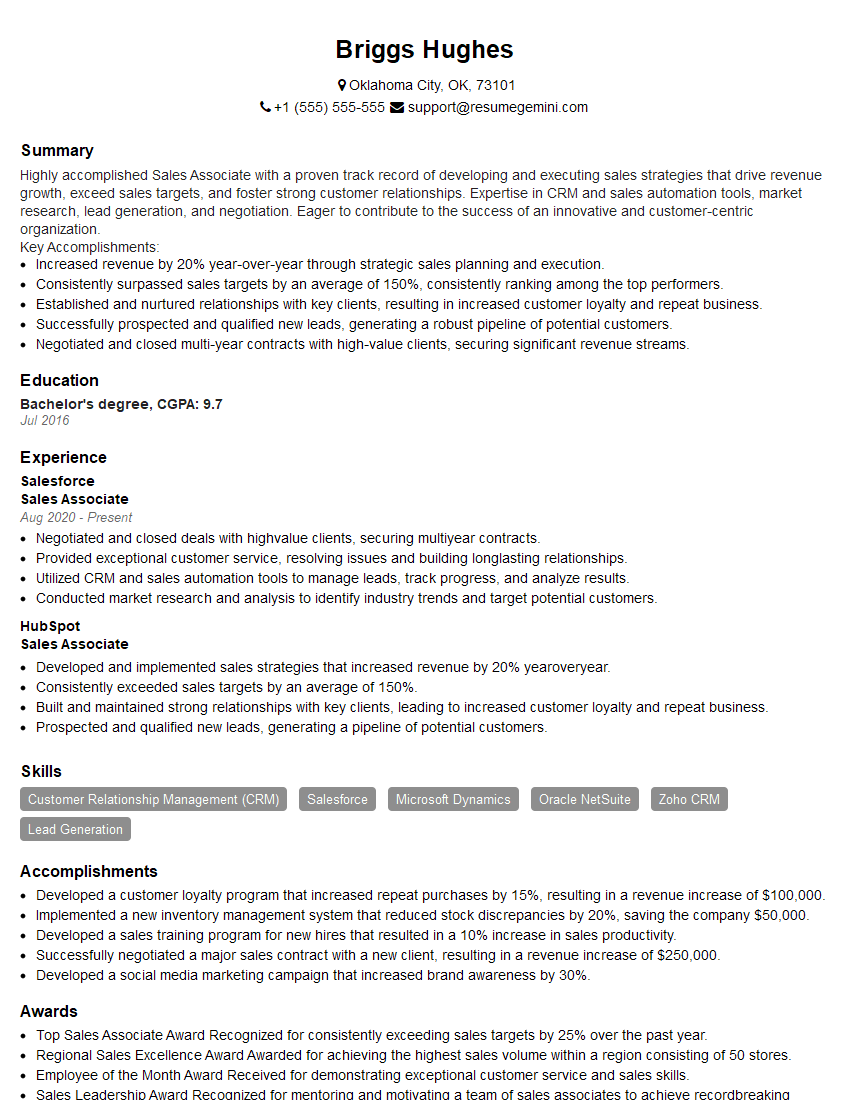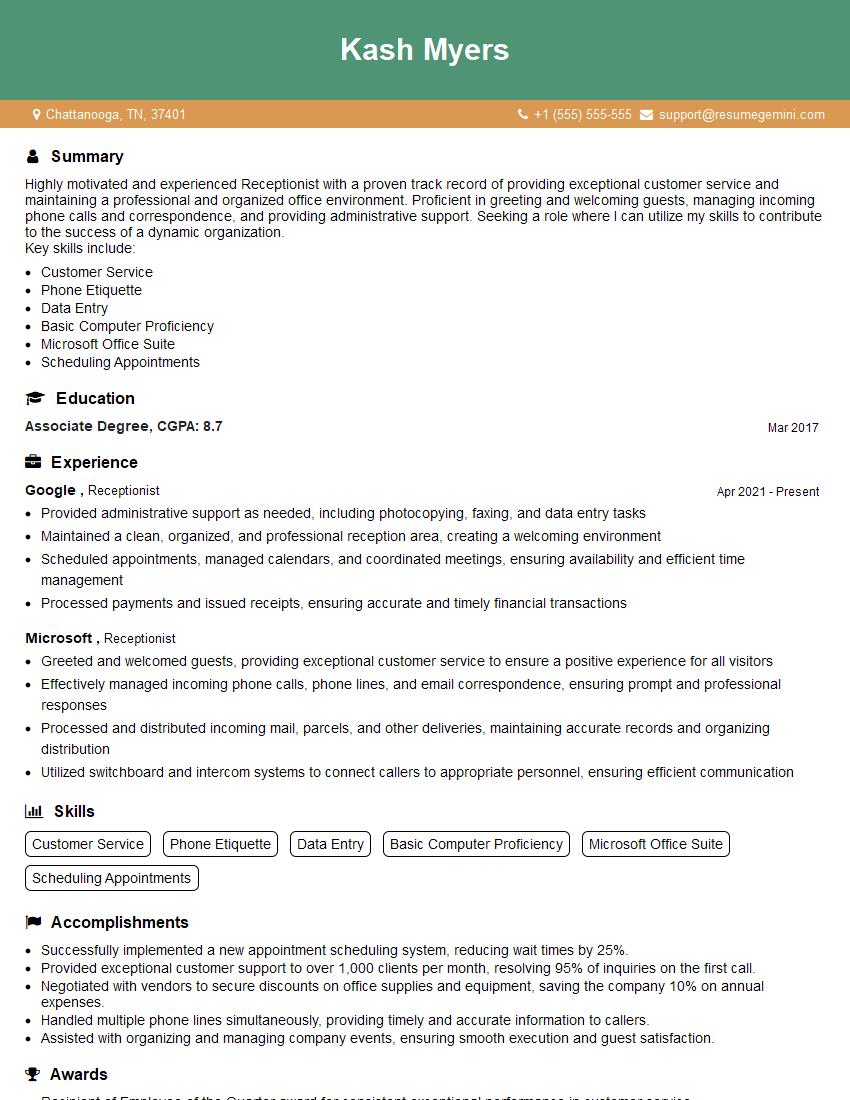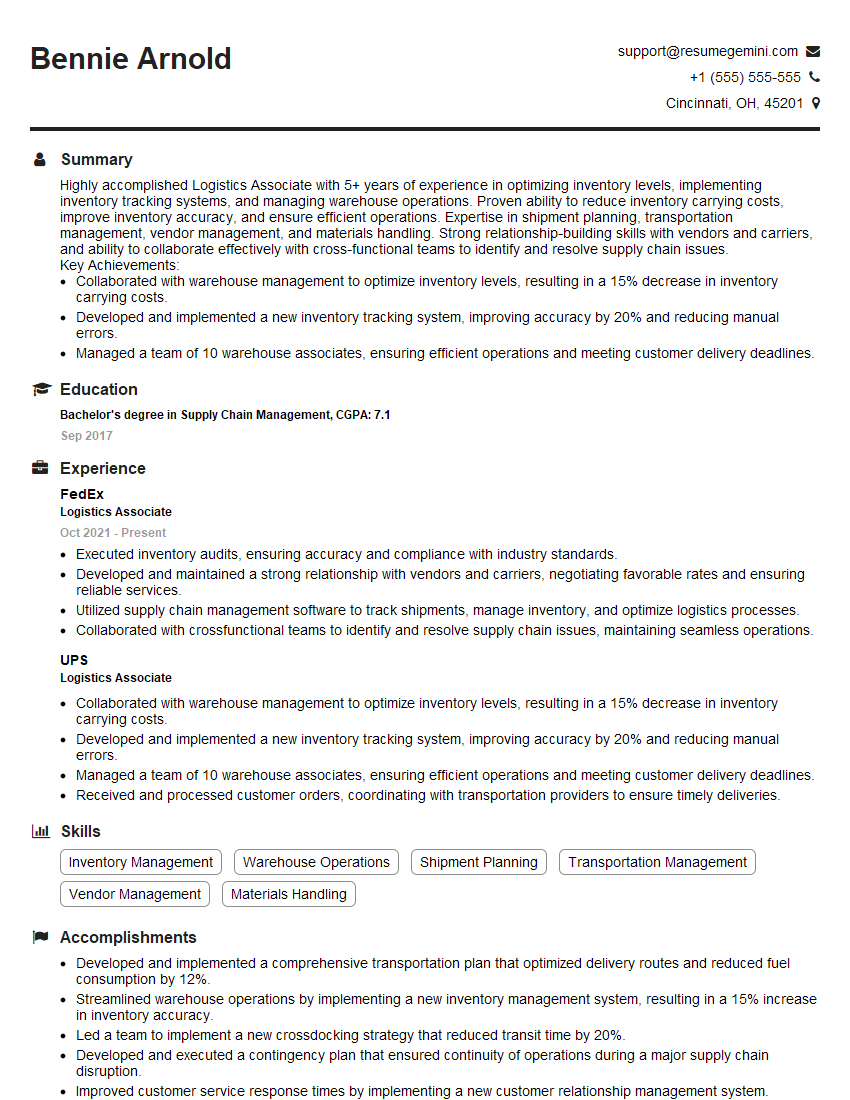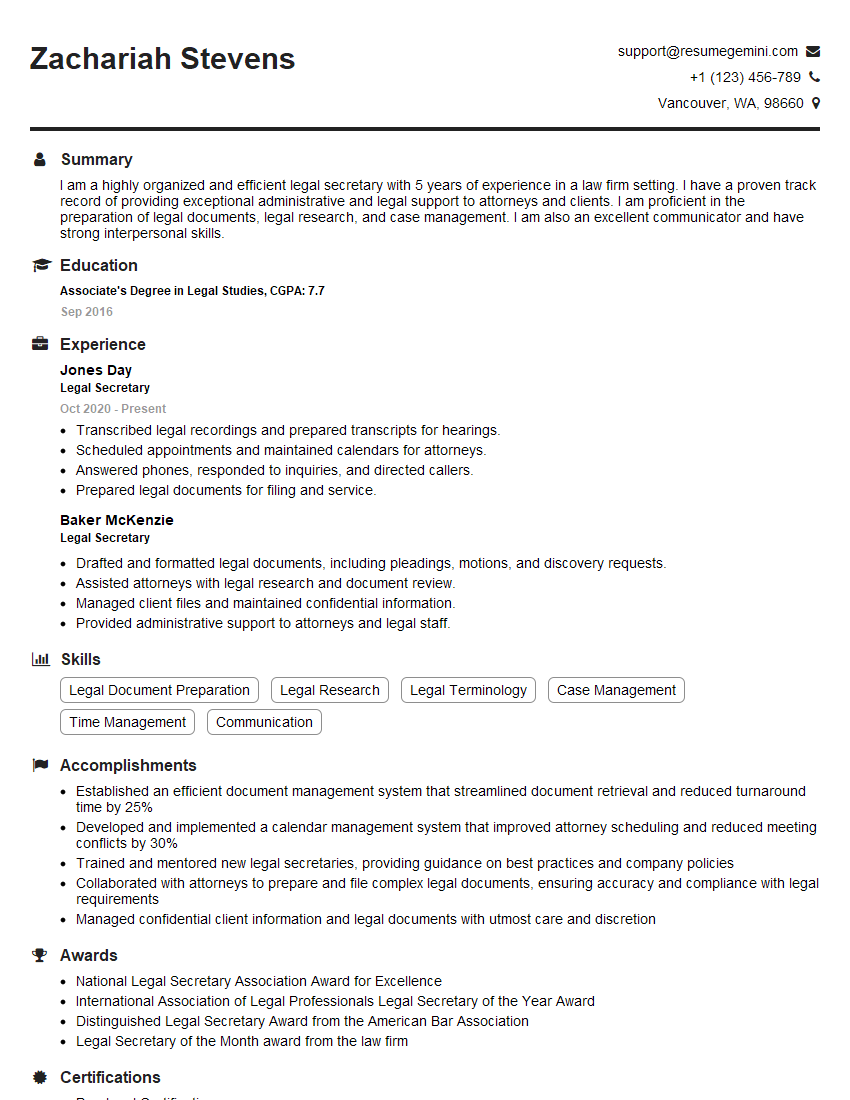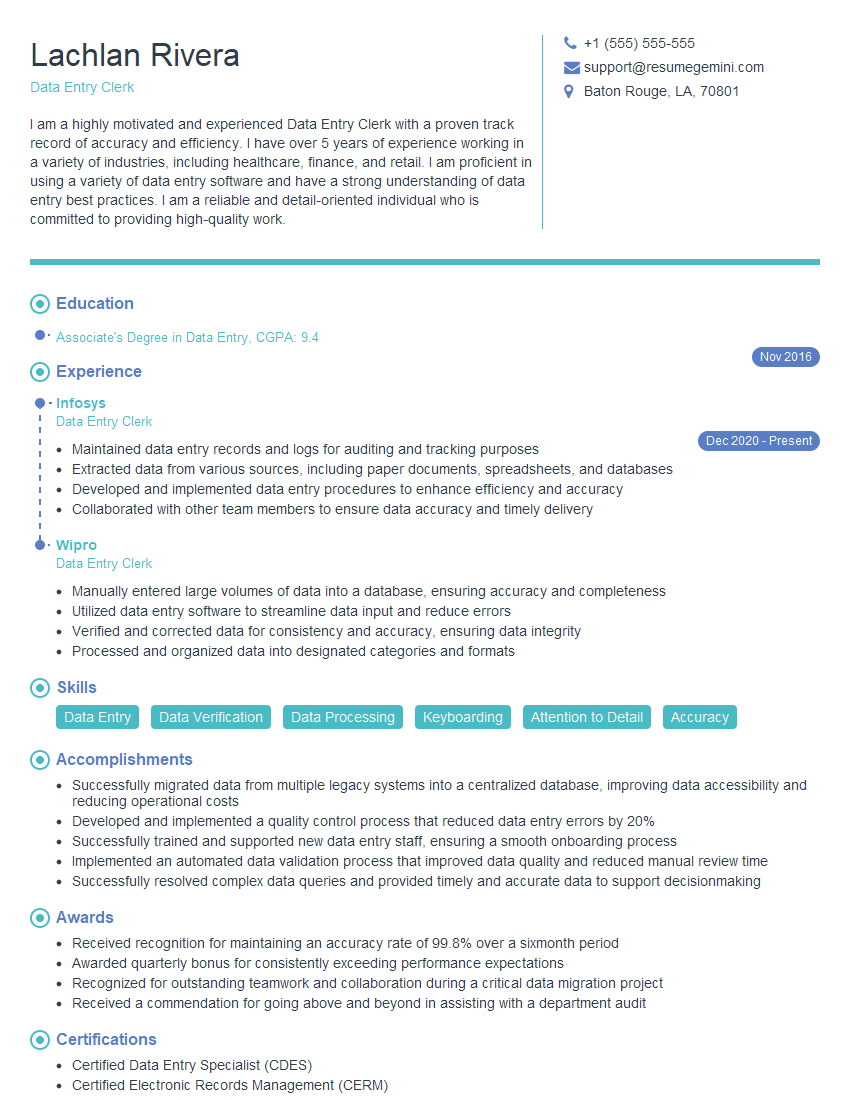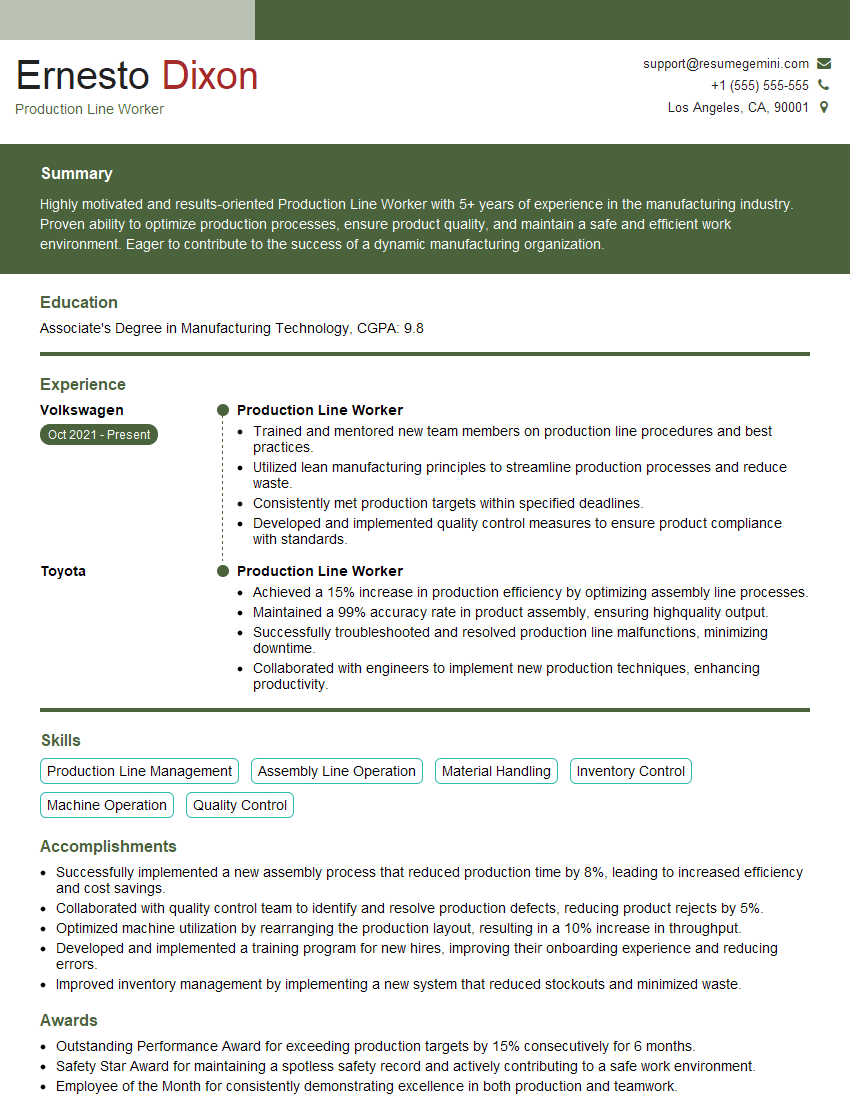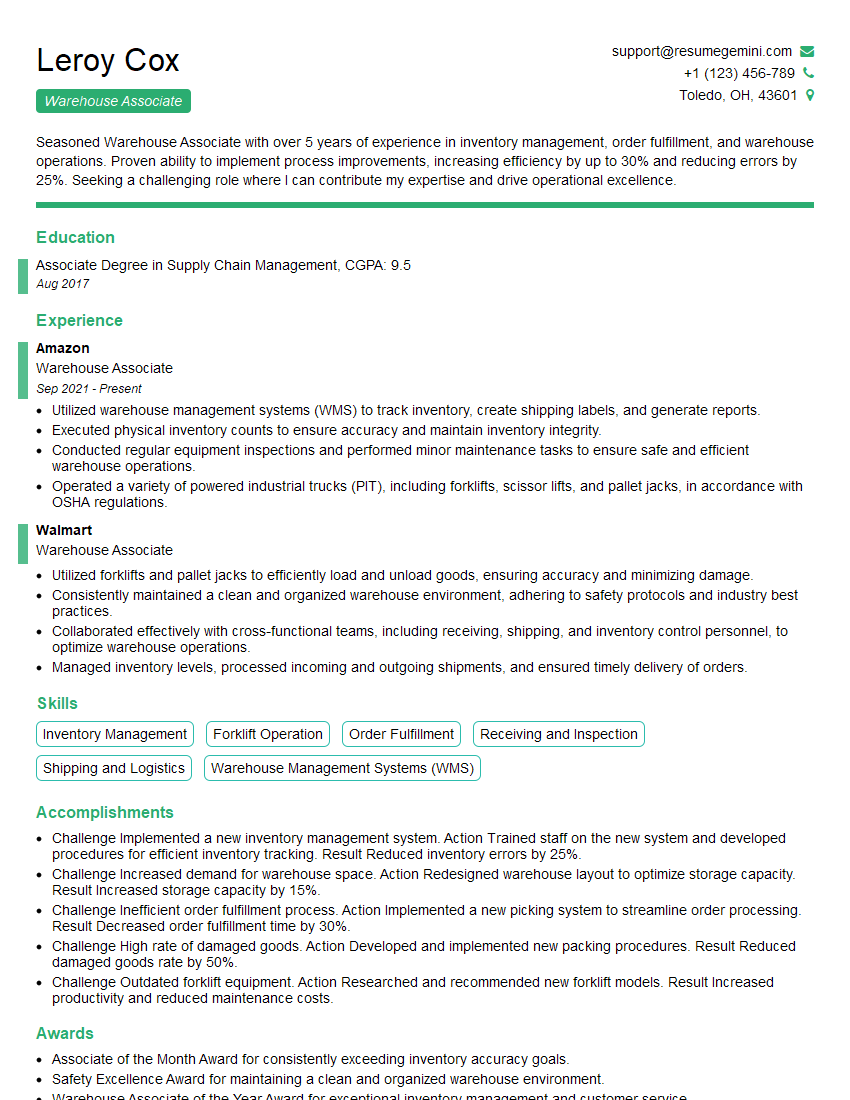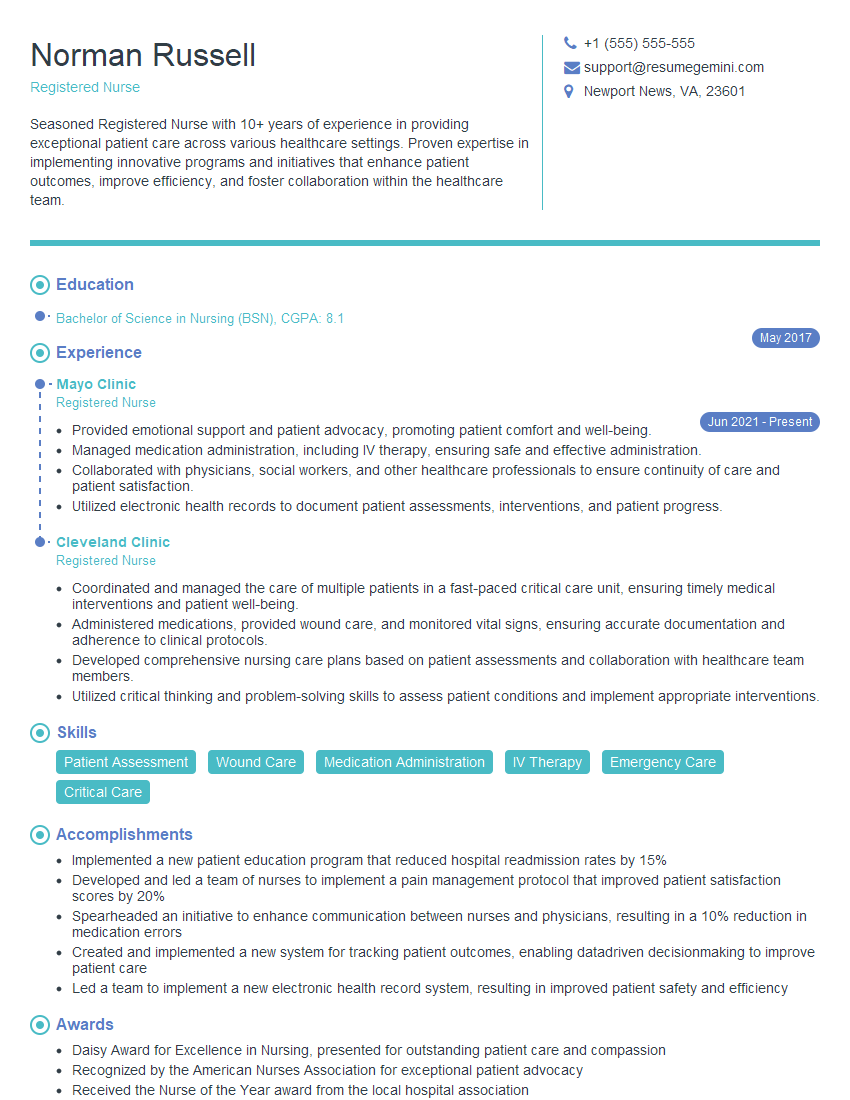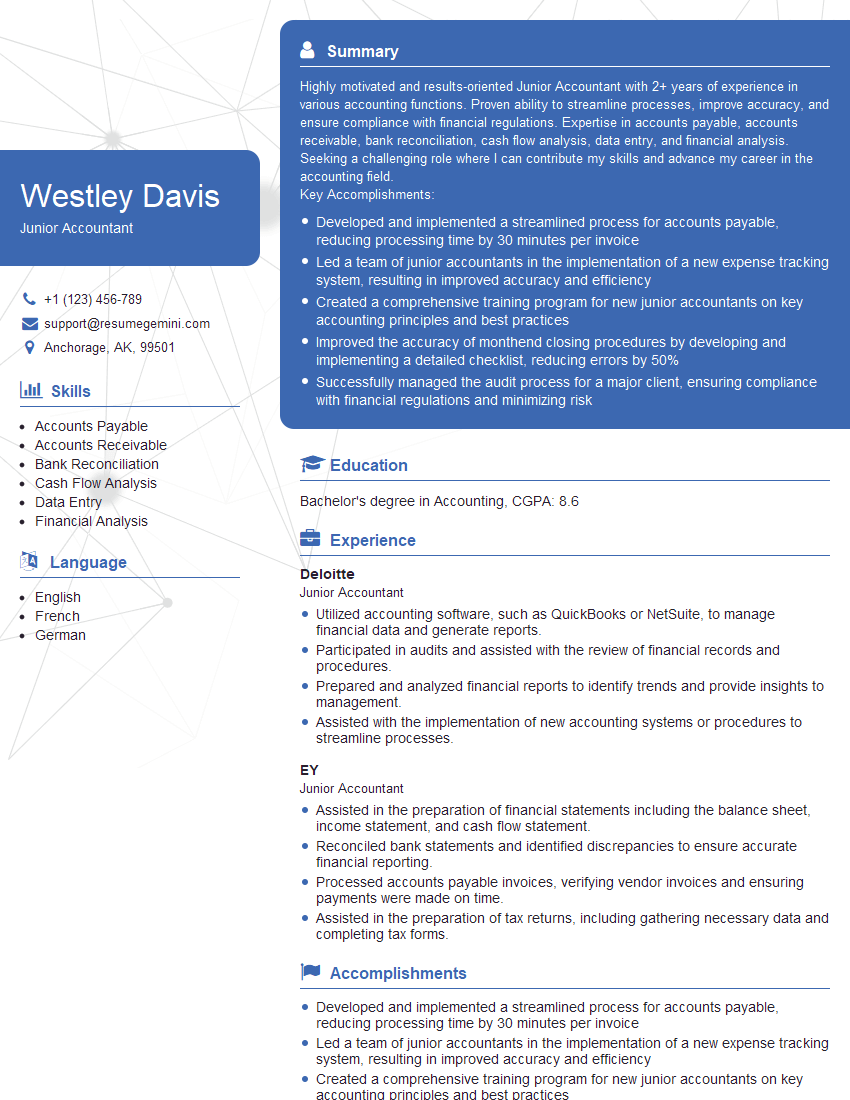Are you ready to stand out in your next interview? Understanding and preparing for Followed instructions and directions from supervisors interview questions is a game-changer. In this blog, we’ve compiled key questions and expert advice to help you showcase your skills with confidence and precision. Let’s get started on your journey to acing the interview.
Questions Asked in Followed instructions and directions from supervisors Interview
Q 1. Describe a time you had to follow complex instructions with limited guidance.
Following complex instructions with limited guidance requires a structured approach. My strategy involves breaking down the task into smaller, manageable steps. I carefully analyze each step, identifying potential roadblocks and clarifying any ambiguities before proceeding. I meticulously document my progress and findings to ensure accuracy and traceability.
For instance, during a previous role at a software company, I was tasked with implementing a new feature using a poorly documented API. The documentation was sparse, and the examples were limited. My approach was to start by meticulously reviewing the available information, creating a flow chart outlining the API calls and expected responses. I then tested each step individually, logging my findings and adjusting my approach as needed. This methodical approach, combined with diligent documentation, ensured successful implementation despite the initial lack of clarity.
Q 2. How do you handle ambiguous instructions or conflicting directives?
Ambiguous instructions or conflicting directives require immediate clarification. I would first attempt to understand the underlying intent behind each instruction. If the ambiguity persists, I prioritize direct communication with my supervisor or the relevant stakeholders. I aim to understand the context, priorities, and potential consequences of each instruction before taking action. I find it helpful to restate my understanding of the instructions to ensure we’re on the same page. If the conflict cannot be resolved, I document the situation, outlining the conflicting instructions and my proposed course of action based on my best judgment.
For example, if I receive instructions to finalize a report by end of day but a separate instruction requests additional data analysis that would extend the deadline, I would directly communicate with my supervisor to prioritize tasks. This could involve discussing the relative importance of each deliverable and finding a mutually agreeable solution, potentially adjusting deadlines or prioritizing features.
Q 3. Explain your process for verifying the accuracy of instructions before beginning a task.
Verifying the accuracy of instructions is crucial. My process begins with a thorough review of all provided documentation, including written instructions, diagrams, or specifications. I actively look for inconsistencies or unclear points. If the instructions lack clarity, I don’t hesitate to ask clarifying questions. If applicable, I may create a checklist or flowchart to visualize the steps involved, ensuring all aspects are accounted for. I also check for updates or revisions to the instructions to ensure I’m working with the latest version.
Imagine I’m given a recipe for a complex dish. I won’t just start cooking. I’ll first read through the whole recipe multiple times, checking if the ingredients are available, and confirming I understand each step. I’d even perhaps check online for the same recipe to cross-reference.
Q 4. Have you ever had to follow instructions that you disagreed with? How did you handle that?
Disagreements with instructions happen, and my approach is professional and respectful. I first carefully consider the reasons behind my disagreement. Is it a matter of safety, practicality, or a potential negative outcome? Then, I respectfully voice my concerns to my supervisor, presenting my rationale with data or evidence to support my position. It’s crucial to maintain a collaborative approach, focusing on finding a solution that aligns with both the organizational goals and best practices.
For example, if I receive instructions to use a method I know is inefficient, I’d approach my supervisor explaining that a more efficient alternative exists, backing it with data on improvement times or cost savings. Ultimately, I follow the final decision, even if it differs from my suggestion, ensuring full commitment to the team’s direction.
Q 5. How do you prioritize tasks when given multiple instructions simultaneously?
Prioritizing tasks with multiple simultaneous instructions requires a systematic approach. I use a prioritization matrix, considering factors such as urgency, importance, and dependencies. Urgency relates to deadlines, while importance relates to the overall impact on project goals. Dependencies determine whether completing one task is necessary before starting another. This method helps me systematically allocate my time and resources effectively.
A simple example: Imagine I have to write a report (high importance, medium urgency), prepare for a presentation (high importance, high urgency), and answer emails (low importance, low urgency). I would prioritize the presentation, then the report, and address emails afterward. My prioritization matrix would clarify this order.
Q 6. Describe a situation where you had to adapt your approach based on new instructions mid-task.
Adapting to new instructions mid-task requires flexibility and adaptability. My process involves acknowledging the change, understanding the reason behind it, and assessing its impact on the current work. I would then adjust my approach accordingly, documenting the changes made and communicating the impact to relevant stakeholders. A clear communication channel is essential to ensure everyone is aligned with the revised plan.
For instance, if I’m designing a website and midway through, I receive new branding guidelines, I wouldn’t scrap the existing work. I would carefully incorporate the changes where possible, highlighting the areas that would require redesigning and seeking approval for any substantial deviations. Maintaining thorough documentation ensures traceability of changes.
Q 7. How do you ensure you understand instructions completely before starting a task?
Ensuring complete understanding of instructions is paramount. My strategy includes active listening, asking clarifying questions, summarizing my understanding, and confirming with the person giving instructions. I use techniques like paraphrasing the instructions in my own words to ensure comprehension. I also review the instructions multiple times before starting the task and create a detailed plan or checklist to guide my work. This multi-faceted approach minimizes the risk of errors or misunderstandings.
For example, after receiving instructions, I’ll often restate them: ‘So, if I understand correctly, the first step is X, then Y, and finally Z. Is that accurate?’ This ensures that both parties are on the same page.
Q 8. How do you manage your time effectively when working with detailed instructions?
Effective time management when working with detailed instructions hinges on meticulous planning and execution. I start by thoroughly reviewing the entire instruction set before beginning any task. This allows me to grasp the overall objective and identify potential challenges upfront. I then break down the instructions into smaller, manageable tasks, prioritizing them based on urgency and dependency. I utilize tools like task management software or even a simple to-do list to track my progress and allocate specific time blocks for each task. Regular breaks are also crucial to maintain focus and prevent burnout. For instance, while working on a complex software implementation project with a lengthy instruction manual, I allocated specific two-hour blocks for coding, interspersed with 15-minute breaks for stretching and refreshing my mind. This segmented approach significantly improved my efficiency and accuracy.
Q 9. How do you document your progress when following complex instructions?
Documenting progress when dealing with complex instructions is paramount for accountability and efficient troubleshooting. My approach involves maintaining a detailed log, which could be a digital document or a physical notebook, depending on the project’s nature. This log includes timestamps, the specific steps completed, any challenges encountered, and the solutions implemented. I also incorporate screenshots or screen recordings, especially for software-related tasks, to provide visual evidence of my progress. For example, during a recent data migration project, my detailed log included not only the number of records transferred at each stage but also screenshots of the database tables before and after the transfer, enabling easy verification. This comprehensive documentation facilitates future reference and simplifies collaboration if necessary.
Q 10. What do you do if you encounter a problem while following instructions?
Encountering problems while following instructions is inevitable, and my response is guided by a systematic approach. First, I carefully reread the relevant sections of the instructions, looking for any overlooked details or clarifications. If the problem persists, I attempt to troubleshoot independently, using my existing knowledge and available resources such as online documentation or internal wikis. If my attempts are unsuccessful, I escalate the issue to my supervisor, providing them with comprehensive context, including the specific step where the problem occurred, the error message (if any), and any troubleshooting steps I’ve already taken. This proactive approach ensures timely resolution and minimizes potential delays.
Q 11. Describe a time you identified an error in instructions. What did you do?
In a previous project involving the setup of a new network infrastructure, I discovered an inconsistency in the provided instructions. The document outlined a specific configuration for the firewall that conflicted with established security protocols within our organization. I didn’t proceed with the conflicting instructions. Instead, I carefully documented the discrepancy, including screenshots of the conflicting sections, and presented my findings to my supervisor. We discussed the potential risks associated with following the incorrect instructions, and collaboratively decided on a revised configuration that aligned with both the instructions’ overall intent and our security standards. This collaborative approach ensured the project’s success and highlighted the importance of critical thinking even when following seemingly clear directions.
Q 12. How do you seek clarification when you don’t understand instructions?
Seeking clarification is a sign of responsibility, not weakness. When faced with unclear instructions, my first step is to review the document thoroughly to see if my initial understanding might be incorrect. If the ambiguity remains, I directly communicate with my supervisor or the appropriate point of contact. I prepare my questions concisely and specifically, providing the relevant context and the section of the instructions I’m struggling to understand. For instance, instead of saying, “I don’t understand this,” I’d say, “In step 3, the document mentions ‘configure port X’. Could you clarify what specific settings are required for port X?” This targeted approach ensures efficient and effective communication, leading to quicker resolution.
Q 13. How do you handle interruptions while following detailed instructions?
Handling interruptions while working on detailed instructions requires discipline and organizational skills. Before starting a task, I inform my colleagues of my need for focused time, minimizing unnecessary distractions. If an interruption occurs, I politely acknowledge it, but I immediately make a note of where I left off in my work to avoid losing my train of thought. Once the interruption is resolved, I review my notes and return to my task, ensuring continuity and minimizing the impact of the interruption. I might even use a timer to help me get back on track and regain focus after an interruption.
Q 14. How do you ensure the accuracy of your work when following instructions?
Ensuring accuracy when following instructions is crucial for successful project outcomes. My approach involves multiple layers of checks and verification. Firstly, I meticulously review each step of the instructions before execution. After completing a task or a set of tasks, I perform a thorough self-check, comparing my output against the expected results outlined in the instructions. This often involves using checklists or other verification tools to confirm that all steps have been correctly followed. Finally, before submitting my work, I conduct a final review, potentially seeking a second opinion from a colleague if the task is particularly critical. This multi-layered approach significantly minimizes errors and ensures the highest possible accuracy.
Q 15. Explain your process for recording and tracking instructions received.
My process for recording and tracking instructions is meticulous and multi-layered, ensuring nothing slips through the cracks. I begin by actively listening during instruction delivery, clarifying any ambiguities immediately. Then, I document everything in a consistent format, typically using a combination of digital and physical methods.
Digitally, I utilize task management software (more on that in the next answer) to create detailed task entries. These entries include the source of the instruction (e.g., email, meeting minutes, verbal communication), the specific instruction itself (verbatim if possible), deadlines, relevant stakeholders, and any supporting documents. I also maintain a physical notebook for quick notes and sketches, especially useful in dynamic situations. Regularly reviewing and updating these records guarantees accuracy and allows for efficient progress tracking.
Think of it like building a house: the instructions are the blueprint, my notes are the detailed sketches, and the software is my overall project management tool. Each piece is vital for the end result.
Career Expert Tips:
- Ace those interviews! Prepare effectively by reviewing the Top 50 Most Common Interview Questions on ResumeGemini.
- Navigate your job search with confidence! Explore a wide range of Career Tips on ResumeGemini. Learn about common challenges and recommendations to overcome them.
- Craft the perfect resume! Master the Art of Resume Writing with ResumeGemini’s guide. Showcase your unique qualifications and achievements effectively.
- Don’t miss out on holiday savings! Build your dream resume with ResumeGemini’s ATS optimized templates.
Q 16. What software or tools have you used to manage tasks and instructions?
Over the years, I’ve utilized various software and tools for managing tasks and instructions, tailoring my choice to the project’s complexity and team requirements. I’ve had extensive experience with project management software like Asana and Trello, which excel at task organization, collaboration, and deadline tracking. For more complex projects involving multiple teams and stakeholders, I’ve leveraged platforms such as Jira, which offer robust features for issue tracking and workflow management. For simpler projects or personal organization, I find tools like Google Tasks and Microsoft To Do sufficient. Ultimately, the best tool depends on the context but my proficiency in various platforms ensures adaptability.
Q 17. Describe your approach to learning new procedures and following associated instructions.
My approach to learning new procedures and instructions is systematic and proactive. I begin by thoroughly reviewing all provided documentation, paying close attention to diagrams, flowcharts, and step-by-step guides. I then actively seek clarification on any ambiguous points, asking questions to ensure complete understanding before commencing the task. I prefer a hands-on approach, performing trial runs or simulations (where feasible) to reinforce my understanding and identify potential challenges early on. This iterative process of learning, testing, and refining ensures proficiency and reduces the risk of errors.
For instance, when learning a new software program, I might start by working through the tutorials, then move on to practical exercises, and finally try implementing the software in a real-world scenario, always seeking feedback to improve my technique. This approach combines theoretical knowledge with practical application, building a solid foundation for future work.
Q 18. How do you handle situations where instructions are unclear or incomplete?
When faced with unclear or incomplete instructions, my priority is to clarify the ambiguities before proceeding. I don’t assume or guess; instead, I proactively seek clarification from the relevant supervisor or stakeholder. My approach involves identifying the specific unclear aspects, gathering any supporting documentation, and formulating concise questions to ensure complete understanding. This proactive communication prevents costly mistakes and ensures the final product meets the required standards. If multiple interpretations are possible, I present those options to my supervisor, requesting guidance on the preferred approach.
For example, if a project brief mentions a ‘significant’ improvement, I’d ask for a quantifiable definition of ‘significant,’ perhaps in terms of percentage increase or specific metrics. This prevents misunderstandings and ensures everyone is on the same page.
Q 19. Describe a time you successfully followed instructions that resulted in a positive outcome.
In a previous role, I was tasked with implementing a new customer relationship management (CRM) system. The instructions were detailed and involved migrating data from our old system, configuring user access permissions, and training our sales team. Following the detailed implementation guide meticulously, I successfully migrated all customer data without any loss, configured access permissions based on user roles, and conducted comprehensive training sessions. This resulted in a seamless transition with minimal disruption to our sales operations. Our sales team quickly adapted to the new system, resulting in improved efficiency and increased sales productivity within the first quarter. This success highlighted the importance of careful attention to detail and the value of accurate instruction following.
Q 20. How do you manage your stress levels when working under pressure with tight deadlines and detailed instructions?
Managing stress under pressure with tight deadlines and detailed instructions requires a strategic approach. I prioritize task breakdown, creating smaller, manageable tasks from the larger project. This helps reduce the feeling of being overwhelmed. I also utilize time management techniques like the Pomodoro Technique, working in focused bursts with short breaks in between. Maintaining open communication with my supervisor ensures early identification of potential bottlenecks and allows for proactive adjustments. Finally, I prioritize self-care, ensuring I get enough sleep, exercise, and downtime to maintain my mental and physical well-being. A healthy mind is crucial for effective performance under pressure.
Q 21. What strategies do you use to stay organized and focused while following many instructions?
Staying organized and focused while following numerous instructions involves a combination of techniques. I utilize task management software to prioritize tasks based on deadlines and importance, visually representing my workload and progress. Color-coding, tagging, and using custom fields in my task management software help with categorization and quick identification. Regular review of my task list and calendar prevents overlooking crucial deadlines. I also practice mindfulness techniques such as deep breathing exercises to maintain focus and minimize distractions. This multi-pronged approach ensures efficient task completion and minimizes the risk of errors.
Q 22. How do you maintain accuracy and consistency when following repetitive instructions?
Maintaining accuracy and consistency when following repetitive instructions is crucial for producing high-quality work and avoiding errors. My approach involves a multi-step process: first, I thoroughly understand the instructions, clarifying any ambiguities with my supervisor. Then, I establish a checklist or a structured workflow to ensure each step is performed systematically. This helps me avoid overlooking details. Finally, I regularly review my work against the instructions and use quality control checks at various stages to identify and correct any deviations. For instance, when processing a large batch of data entry tasks, I might check my work every 10 entries, comparing against the source document, to catch errors early. This prevents the accumulation of small mistakes that can escalate into larger problems.
Q 23. How do you communicate any challenges encountered while following instructions to your supervisor?
Open and timely communication is vital when facing challenges. I believe in proactive reporting. If I encounter a problem, I immediately document the issue, including specific details like the step where the problem occurred, any error messages received, and my attempts to resolve it. Then, I schedule a quick meeting or send a concise email to my supervisor, outlining the challenge and suggesting potential solutions. This allows for collaborative problem-solving. For example, if I encounter an unexpected data format in a file, I’d report this promptly, describing the discrepancy and proposing alternative processing methods or suggesting a clarification on the data source.
Q 24. How do you proactively identify potential issues or problems before they arise while following instructions?
Proactive issue identification involves anticipating potential problems before they impact the workflow. I do this by carefully reviewing instructions for potential ambiguities or inconsistencies and asking clarifying questions upfront. I also consider the larger context – what could go wrong? Could there be issues with resource availability (software, data, equipment)? Could external factors affect the task? For example, if instructed to send a marketing email to a large list of recipients, I would proactively check the email list for duplicates, bounces, or invalid addresses to prevent delivery failures and ensure the campaign’s success. A risk assessment, even for seemingly simple tasks, can help prevent bigger issues later.
Q 25. Describe a time you had to follow safety regulations and instructions.
During my time working in a laboratory setting, safety was paramount. We were required to follow strict protocols for handling hazardous materials. One instance involved using a centrifuge – a high-speed spinning machine. Before operating the centrifuge, I meticulously followed the safety guidelines: I balanced the tubes precisely to avoid vibrations, ensured the lid was securely closed, and wore appropriate personal protective equipment (PPE), including safety glasses and gloves. I also visually inspected the machine for any damage before starting it. Adherence to these instructions prevented any potential accidents or injuries. A thorough understanding of safety regulations and proactive attention to detail are crucial in such environments.
Q 26. How do you ensure your work aligns with company policies and procedures when following instructions?
Aligning my work with company policies and procedures is fundamental. Before starting any task, I review relevant company documentation, including internal guidelines, style guides, and any specific protocols related to the project. I also utilize any internal resources like knowledge bases or training materials to ensure my understanding is complete. If there are any grey areas or uncertainties, I clarify them with my supervisor before proceeding. This proactive approach minimizes the risk of non-compliance and ensures the quality of my work meets company standards. For example, when preparing a report, I’d ensure the format, style, and content adhere to the company’s established guidelines for such documents.
Q 27. Describe a time you went above and beyond to ensure precise adherence to instructions.
In a previous role, I was tasked with creating a large database of customer information. The instructions were incredibly detailed and required rigorous data validation. While the initial instructions seemed straightforward, I proactively added an extra layer of verification. After completing the data entry, I independently cross-referenced the information with an alternative data source to ensure accuracy. This extra step, while not explicitly requested, identified several inconsistencies that might have gone unnoticed. It guaranteed the data’s integrity and saved time and effort in the long run. Demonstrating this level of commitment shows a dedication to quality and accuracy that goes beyond the minimum requirements.
Q 28. Have you ever received constructive criticism on your ability to follow instructions? How did you respond?
Yes, I once received feedback suggesting I could be more proactive in identifying potential roadblocks before starting a task. While I generally followed instructions meticulously, I was sometimes too focused on the execution and missed opportunities for preventative measures. I took this feedback very seriously. I developed strategies to proactively anticipate challenges, as previously described, and began documenting my thought processes before starting tasks, which helped identify potential issues. I also sought more feedback on my work and actively participated in team discussions to improve my anticipatory skills. Constructive criticism is invaluable for continuous improvement, and I am grateful for the opportunity to learn and grow.
Key Topics to Learn for “Followed Instructions and Directions from Supervisors” Interview
- Understanding Instructions: Analyzing instructions for clarity, identifying key tasks, and recognizing potential ambiguities. This includes active listening and clarifying any uncertainties before proceeding.
- Prioritization and Time Management: Effectively prioritizing tasks based on urgency and importance, managing time efficiently to meet deadlines, and adapting to changing priorities as directed by supervisors.
- Execution and Problem-Solving: Implementing instructions accurately and efficiently, proactively identifying and addressing potential roadblocks, and seeking guidance when necessary, demonstrating resourcefulness and initiative.
- Communication and Feedback: Regularly updating supervisors on progress, effectively communicating challenges or unexpected issues, and actively seeking and incorporating feedback to improve performance.
- Documentation and Record-Keeping: Maintaining accurate records of completed tasks, following established procedures for documentation, and ensuring all work is properly documented and readily accessible.
- Adaptability and Flexibility: Demonstrating the ability to adjust to changing instructions, new priorities, and unexpected situations while maintaining productivity and accuracy.
- Teamwork and Collaboration: Working effectively within a team environment, following instructions from multiple supervisors or team leads, and coordinating tasks to ensure overall project success.
Next Steps
Mastering the ability to follow instructions and directions is paramount for career success. It demonstrates reliability, competence, and a commitment to teamwork, all essential qualities employers value highly. To significantly improve your job prospects, focus on creating an ATS-friendly resume that effectively highlights your skills and experiences in this area. ResumeGemini is a trusted resource that can help you build a professional and impactful resume. We provide examples of resumes tailored to showcasing experience in following instructions and directions – take advantage of these resources to elevate your application!
Explore more articles
Users Rating of Our Blogs
Share Your Experience
We value your feedback! Please rate our content and share your thoughts (optional).
What Readers Say About Our Blog
Hi, I have something for you and recorded a quick Loom video to show the kind of value I can bring to you.
Even if we don’t work together, I’m confident you’ll take away something valuable and learn a few new ideas.
Here’s the link: https://bit.ly/loom-video-daniel
Would love your thoughts after watching!
– Daniel
This was kind of a unique content I found around the specialized skills. Very helpful questions and good detailed answers.
Very Helpful blog, thank you Interviewgemini team.






